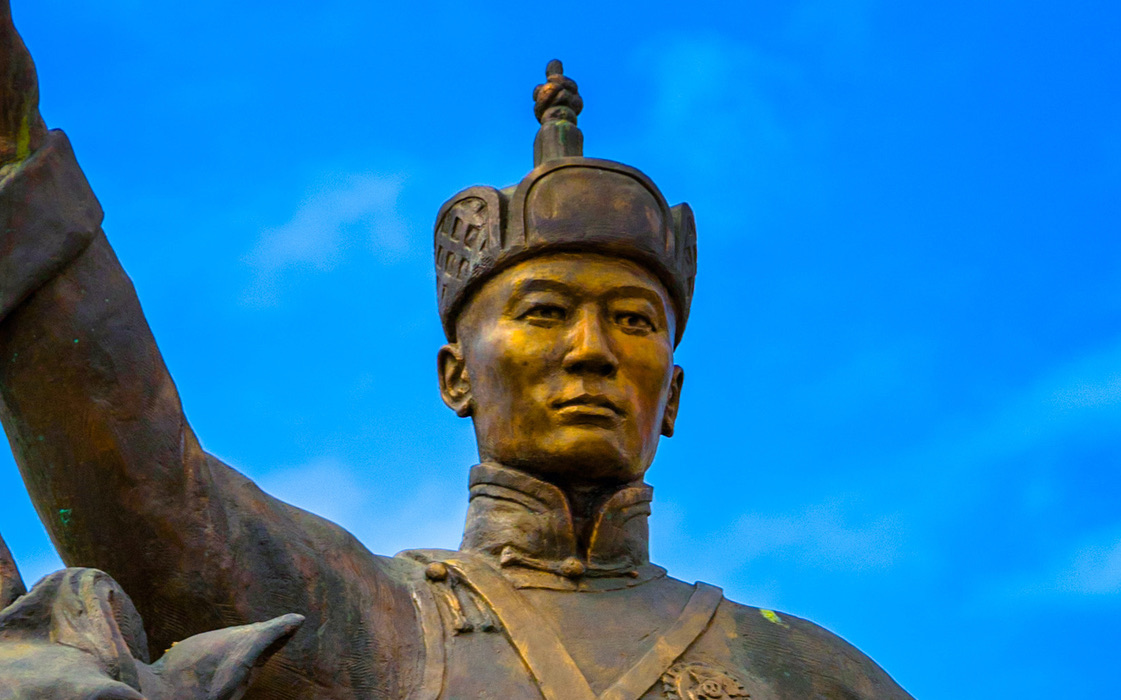SUKHBAATAR’S STATUE – THE FIGHT IS NOT OVER
For Sukhbaatar Damdin, the situation in the country had become unbearable. As a charismatic orator, political activist and visionary leader, Sukhbaatar decided to take matters into his own hands and actively recruited brave men throughout the country to organize a militia. The most direct way to a solution, as he saw it, was to join forces with the emerging power of the Russian Red Army who could support them with manpower and weapons. After repeated attempts, he and his fellow patriots (D.Bodoo, S.Danzan, Kh.Choibalsan, D.Losol, D.Dogsom, D.Chagdarjav, and many others)1 succeeded in convincing the Bolsheviks to ally with their party. On March 18, 1921, his army fought invaders to a decisive victory in Kyakhta (port city North of Mongolia). The same year, Sukhbaatar and the Russian Red Armies freed Niislel Khuree (Ulaanbaatar after 1924) and on July 11, 1921, Mongolia celebrated its sovereignty. Sukhbaatar was working devoutly to strengthen the national security and the newly formed government when on February 20, 1923, the thirty-year-old leader died, according to some sources, from complications of pneumonia. Myths and controversies as to the nature of his death exist to this day – many people suspect that he was poisoned.
Sukhbaatar was a daredevil sharpshooter on horseback, affectionally nicknamed Noodle-Baatar by his fellow soldiers for his trick-riding skills. He was revered by his army not only for his leadership and conviction, but also for his amiable and honest character. A beloved hero, he was deeply mourned by the nation after his untimely death. In 1946, his former partner in mission, Kh.Choibalsan (head of state, 1939-1952) issued a decree to erect a monument in Sukhbaatar’s honor on the spot where he addressed the public to declare the country’s victory for independence. In his 1948 memoir, Kh.Choibalsan wrote, “It is the civic duty of every citizen to remember Sukhbaatar’s service for our motherland.”2
After years of careful research, planning and preparation, a team of sculptors (S.Choimbol, D.Damdimaa, Lkhamsuren, Purev, N.Jambaa, Ravdan, Danzan, Danshii), many dedicated craftsmen (Sh.Nayantai, A.Davaatseren) and laborers including Japanese POW’s worked relentlessly to complete the monument in time for the 25th anniversary of the proclamation of Mongolian People’s Republic. The monument is altogether around 11 meters high, the equestrian statue being about four meters tall. The statue depicts the hero’s actions and personality. His gallant, straight-backed figure sits astride a spirited horse standing triumphantly on top of a cliff facing the sunrise. Sukhbaatar’s facial expression is stern and resolute. He is turned toward his left side, raising his right arm with the palm facing upwards to call for his people to fight for their freedom. Two plaques commemorating the revolution are set on each side of the cliff. The tablet on his right side is an action scene of the commander leading his army into battle. The tablet on his left – shows his address to the people declaring the nation’s independence. Fourteen lions clenching a huge chain surround the statue to symbolize protection and strength. In 2010, the monument was restored and bronzed, which allows many beautiful details of the sculpture to stand out more clearly. The front side of the cliff is inscribed with a quote from Sukhbaatar’s speech, which reads:
“The power within our souls knows that if only we unite our strength and mind as one nation and summon our potential to move bravely forward with resolve, there is no place we cannot go, nothing we cannot achieve; [no one] (no external or internal adversary, no suffering we may encounter)* will hold us back from reaching prosperity.” *(edited out by Choibalsan in 1946)3.
At the close of the 20th century, Sukhbaatar’s statue was a witness to the peaceful democratic revolution, which was an achievement worthy of the hero’s legacy. However, in the wake of the 21st century, this monument calls to attention that the fight for freedom is not over. Today, Mongolians are once again faced with a sly and even more dangerous adversary.
Corruption is the rapacious monster that is slowly eating away at the nation’s hard-earned freedom from the inside. The enemy of high moral standing, it is holding us back from growth and prosperity. Sukhbaatar’s statue calls for every citizen to fight against corruption, to stubbornly resist it, to follow the hero’s example and eliminate it, so that it may never come back to threaten our childrens’ well being again.
If we, Mongolians, take care to cultivate a strong ethic, create a culture that does not endorse cheating or bribing, and develop an immunity against corruption, then as Sukhbaatar said, “Nothing will hold us back from reaching prosperity.”
His legacy embodied in his magnificent monument is the tower of strength that reminds us, this too can be achieved.
[1] N. Khishigt, “1921 Оны Хувьсгалын Түүхэнд Д.Сүхбаатарын Эзлэх Байр Суурь: 1990-ээд Оноос Хойшхи Түүх Бичлэгийн Асуудалд”[2] Z. Seseer, Д.Сүхбаатар – Монгол Орон, (Ulaanbaatar: New Indigo, 2020), p.49.
[3] Ch.Dashdavaa et al., Сүхбаатарын Хөшөөний Үнэн Түүх, (Ulaanbaatar: Admon, 2011), p.41.
By Ariunaa Jargalsaikhan
Published in UB Post on July 20, 2020
Ulaanbaatar









